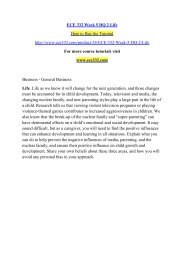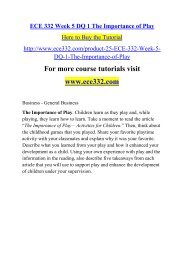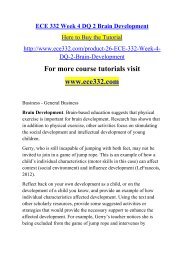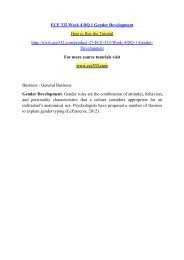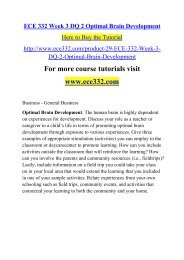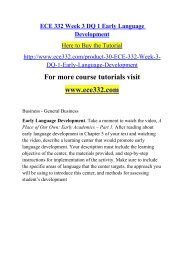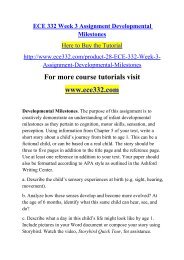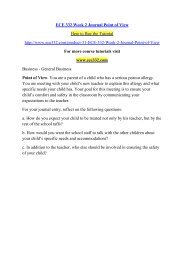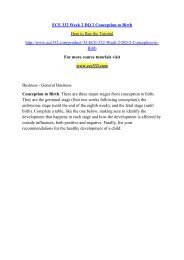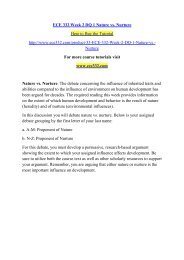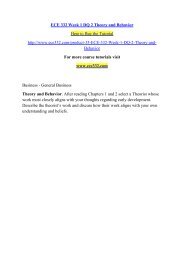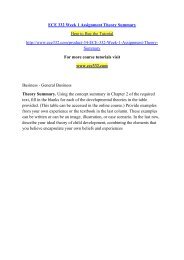ECE 332 Week 1 DQ 1 Benefits of Preschool
Create successful ePaper yourself
Turn your PDF publications into a flip-book with our unique Google optimized e-Paper software.
<strong>ECE</strong> <strong>332</strong> <strong>Week</strong> 1 <strong>DQ</strong> 1 <strong>Benefits</strong> <strong>of</strong> <strong>Preschool</strong>Here to Buy the Tutorialhttp://www.ece<strong>332</strong>.com/product-36-<strong>ECE</strong>-<strong>332</strong>-<strong>Week</strong>-1-<strong>DQ</strong>-1-<strong>Benefits</strong>-<strong>of</strong>-<strong>Preschool</strong>For more course tutorials visitwww.ece<strong>332</strong>.comBusiness - General Business<strong>Benefits</strong> <strong>of</strong> <strong>Preschool</strong>. As an early childhood pr<strong>of</strong>essional, you will <strong>of</strong>ten beasked questions from parents and community members regarding the benefits <strong>of</strong>sending their children to preschool. After reading Chapter 1 and drawing fromyour experience, discuss the benefits <strong>of</strong> a preschool educationTheory and Behavior. After reading Chapters 1 and 2 select a Theorist whosework most closely aligns with your thoughts regarding early development.Describe the theorist’s work and discuss how their work aligns with your ownunderstanding and beliefs.Theory Summary. Using the concept summary in Chapter 2 <strong>of</strong> the requiredtext, fill in the blanks for each <strong>of</strong> the developmental theories in the tableprovided. (This table can be accessed in the online course.) Provide examplesfrom your own experience or the textbook in the last column. These examplescan be written or can be an image, illustration, or case scenario. In the last row,describe your ideal theory <strong>of</strong> child development, combining the elements thatyou believe encapsulate your own beliefs and experiencesNature vs. Nurture. The debate concerning the influence <strong>of</strong> inherited traits andabilities compared to the influence <strong>of</strong> environment on human development hasbeen argued for decades. The required reading this week provides informationon the extent <strong>of</strong> which human development and behavior is the result <strong>of</strong> nature(heredity) and <strong>of</strong> nurture (environmental influences).In this discussion you will debate nature vs. nurture. Below is your assigneddebate grouping by the first letter <strong>of</strong> your last name:a. A-M: Proponent <strong>of</strong> Nature
. N-Z: Proponent <strong>of</strong> NurtureFor this debate, you must develop a persuasive, research-based argumentshowing the extent to which your assigned influence affects development. Besure to utilize both the course text as well as other scholarly resources to supportyour argument. Remember, you are arguing that either nature or nurture is themost important influence on development.Conception to Birth. There are three major stages from conception to birth.They are the germinal stage (first two weeks following conception); theembryonic stage (until the end <strong>of</strong> the eighth week); and the fetal stage (untilbirth). Complete a table, like the one below, making sure to identify thedevelopment that happens in each stage and how the development is affected byoutside influences, both positive and negative. Finally, list yourrecommendations for the healthy development <strong>of</strong> a child.Point <strong>of</strong> View. You are a parent <strong>of</strong> a child who has a serious peanut allergy.You are meeting with your child’s new teacher to explain this allergy and whatspecific needs your child has. Your goal for this meeting is to ensure yourchild’s comfort and safety in the classroom by communicating yourexpectations to the teacher.For your journal entry, reflect on the following questions:a. How do you expect your child to be treated not only by his teacher, but by therest <strong>of</strong> the school staff?b. How would you want the school staff to talk with the other children aboutyour child’s specific needs and accommodations?c. In addition to the teacher, who else should be involved in ensuring the safety<strong>of</strong> your child?Early Language Development. Take a moment to watch the video, A Place <strong>of</strong>Our Own: Early Academics – Part 1. After reading about early languagedevelopment in Chapter 5 <strong>of</strong> your text and watching the video, describe alearning center that would promote early language development. Yourdescription must include the learning objective <strong>of</strong> the center, the materialsprovided, and step-by-step instructions for implementation <strong>of</strong> the activity. Makesure to include the specific areas <strong>of</strong> language that the center targets, the
approach you will be using to introduce this center, and methods for assessingstudent’s development.Optimal Brain Development. The human brain is highly dependent onexperiences for development. Discuss your role as a teacher or caregiver in achild’s life in terms <strong>of</strong> promoting optimal brain development through exposureto various experiences. Give three examples <strong>of</strong> appropriate stimulation(activities) you can employ in the classroom or daycarecenter to promotelearning. How can you include activities outside the classroom that willreinforce the learning? How can you involve the parents and communityresources (i.e., fieldtrips)? Lastly, include information on a field trip you couldtake your class on in your local area that would extend the learning that youincluded in one <strong>of</strong> your sample activities. Relate experiences from your ownschooling such as field trips, community events, and activities that connectedyour learning to both the community and your home.Developmental Milestones. The purpose <strong>of</strong> this assignment is to creativelydemonstrate an understanding <strong>of</strong> infant developmental milestones as theypertain to cognition, motor skills, sensation, and perception. Using informationfrom Chapter 5 <strong>of</strong> your text, write a short story about a child’s journey frombirth to age 1. This can be a fictional child, or can be based on a real child. Thestory should be three to five pages in addition to the title page and the referencepage. Use at least one reference in addition to your text. Your paper should alsobe formatted according to APA style as outlined in the Ashford Writing Center.a. Describe the child’s sensory experiences at birth (e.g. sight, hearing,movement).b. Analyze how these senses develop and become more evolved? At the age <strong>of</strong>6 months, identify what this same child can hear, see, and do?c. Describe what a day in this child’s life might look like by age 1. Includepictures in your Word document or compose your story using Storybird. Watchthe video, Storybird Quick Tour, for assistance.If you choose to create your story in Storybird, you may collaborate with apartner in class by using the collaboration tool. Make sure to notify yourinstructor <strong>of</strong> your collaboration and make sure both <strong>of</strong> you submit yourStorybird link in a Word document for grading. Include the followingdevelopmental milestones in your story:
a. Social and Emotional§ Enjoys imitating people in his play.§ Shows specific preferences for certain people and toys.§ Tests parental responses to his actions during feedings.§ Tests parental responses to his behavior.§ Prefers mother and/or regular caregiver over all others.§ Repeats sounds or gestures for attention.§ Finger-feeds himself.§ Extends arm or leg to help when being dressed.b. Cognitive§ Explores objects in many different ways (shaking, banging, throwing,dropping).§ Finds hidden objects easily.§ Looks at correct picture when the image is named.§ Imitates gestures.§ Begins to use objects correctly (drinking from cup, brushing hair, dialingphone, listening to receiver).c. Language§ Pays increasing attention to speech.§ Responds to simple verbal requests.§ Responds to “no.”§ Uses simple gestures, such as shaking head for “no.”§ Babbles with inflection (changes in tone).§ Says “dada” and “mama.”§ Uses exclamations, such as “Oh-oh!”
§ Tries to imitate words.d. Motor§ Reaches sitting position without assistance.§ Crawls forward on belly.§ Assumes hands-and-knees position.§ Creeps on hands and knees.§ Gets from sitting to crawling or prone (lying on stomach) position.§ Pulls self up to stand.§ Walks holding on to furniture.§ Stands momentarily without support.§ May walk two or three steps without support.e. Hand and Finger Skills§ Uses pincer grasp.§ Bangs two objects together.§ Puts objects into container.§ Takes objects out <strong>of</strong> container.§ Lets objects go voluntarily.§ Pokes with index finger.§ Tries to imitate scribbling.Gender Development. Gender roles are the combination <strong>of</strong> attitudes, behaviors,and personality characteristics that a culture considers appropriate for anindividual’s anatomical sex. Psychologists have proposed a number <strong>of</strong> theoriesto explain gender typing (LeFrancois, 2012).Brain Development. Brain-based education suggests that physical exercise isimportant for brain development. Research has shown that in addition tophysical exercise, other activities focus on stimulating the social developmentand intellectual development <strong>of</strong> young children.
Gerry, who is still incapable <strong>of</strong> jumping with both feet, may not be invited tojoin in a game <strong>of</strong> jump rope. This is an example <strong>of</strong> how a child’s individualcharacteristics (motor skills in this case) can affect context (social environment)and influence development (LeFrancois, 2012).Reflect back on your own development as a child, or on the development <strong>of</strong> achild you know, and provide an example <strong>of</strong> how individual characteristicsaffected development. Using the text and other scholarly resources, providesome suggested activities or strategies that would provide the necessary supportto enhance the affected development. For example, Gerry’s teacher notices sheis being excluded from the game <strong>of</strong> jump rope and intervenes by showing Gerryhow to twirl the rope. Gerry is now included socially, despite her delayed motordevelopment.The Importance <strong>of</strong> Play. Children learn as they play and, while playing, theylearn how to learn. Take a moment to read the article “The Importance <strong>of</strong> Play –Activities for Children.” Then, think about the childhood games that you played.Share your favorite playtime activity with your classmates and explain why itwas your favorite. Describe what you learned from your play and how itenhanced your development as a child. Using your own experience with playand the information in the reading, also describe five takeaways from eacharticle that you will use to support play and enhance the development <strong>of</strong>children under your supervision.Life. Life as we know it will change for the next generation, and those changesmust be accounted for in child development. Today, television and media, thechanging nuclear family, and new parenting styles play a large part in the life <strong>of</strong>a child. Research tells us that viewing violent television programs or playingviolence-themed games contributes to increased aggressiveness in children. Wealso know that the break-up <strong>of</strong> the nuclear family and “super-parenting” canhave detrimental effects on a child’s emotional and social development. It maysound difficult, but as a caregiver, you will need to find the positive influencesthat can enhance development and learning in all situations. Explain what youcan do to help prevent the negative influences <strong>of</strong> media, parenting, and thenuclear family, and ensure their positive influence on child growth anddevelopment. Share your own beliefs about these three areas, and how you willavoid any personal bias in your approach.Final Paper
For the Final Project, you will demonstrate your understanding <strong>of</strong> the materialin this course by developing a classroom plan for either an infant/toddlerchildcare facility or for a preschool classroom, based on Piaget’s Stage Theory.For this project, include:a. Summarize Piaget’s Stage Theory in your own words.b. Identify and describe the developmental characteristics <strong>of</strong> the selected agegroup.c. Design and describe the physical layout <strong>of</strong> facility or classroom that alignswith Piaget’s Stage Theory. Use evidence from the text or other scholarlyresources when describing your layout. (You may use a s<strong>of</strong>tware applicationthat provides graphic layouts like Classroom Architect, or create your layout ina word document.)d. Create one activity for each developmental domain. Make sure to include adetailed description with a step-by-step procedure that includes requiredmaterials (i.e. clay, puzzles, etc.). Discuss how each <strong>of</strong> these activitiesmaximizes development and align to Piaget’s Stage Theory.




